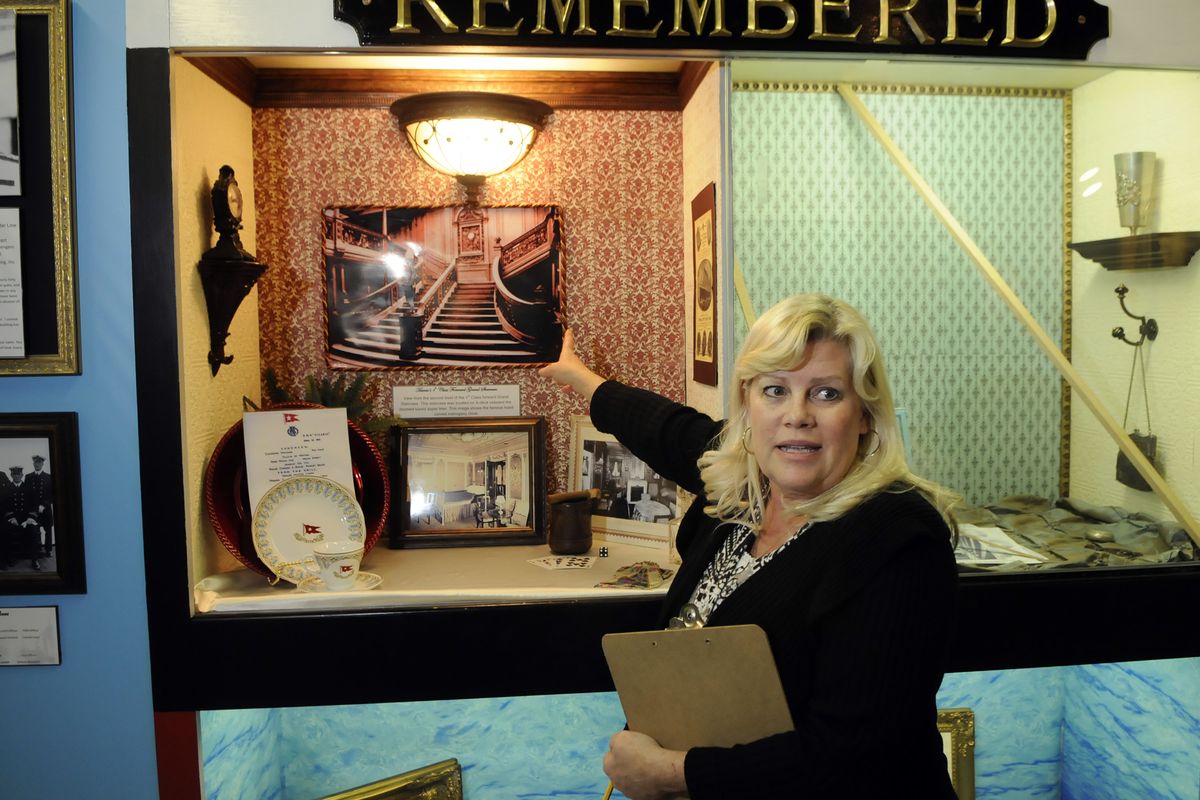Titanic exhibit explores historic ship’s story, local connections

It has been nearly 100 years since Titanic sank after hitting an iceberg, claiming more than 1,500 lives.
The ship, touted as “practically unsinkable,” left port at Southampton, England, April 10, 1912. It stopped in France and Ireland before it set off on its maiden voyage to New York City. The White Star Line, which owned Titanic, knew that the sheer size of the ship wouldn’t make it one of the fastest passenger ships, so they settled for making it the most opulent. Cruising on Titanic meant spending a week in luxury, especially for first-class passengers.
The ship was traveling at top speed through waters the crew had heard were especially icy. The ship hit an iceberg at 11:39 p.m. April 14. It sunk at 2:20 a.m. April 15, 1912.
In observance of the disaster, the Spokane Valley Heritage Museum has created an exhibit chronicling the ill-fated vessel and some of the lives lost.
The event captured the imagination of the world. There have been movies, Broadway plays and books about what could have happened that night. Those of a certain age may remember a time when no one knew where the wreckage lay at the bottom of the ocean. Explorers didn’t find it until 1985.
This year James Cameron is re-releasing his Oscar-winning movie, “Titanic,” in 3-D. One cruise ship company is offering a Titanic Memorial Cruise that will stop in each port and offer lectures about the disaster and a memorial service at 2:20 a.m. April 15 over the site of the wreckage.
Volunteer Jeff Danner, who sort of looks like Capt. Edward Smith who went down with his ship, has been researching Titanic for six or seven months.
“Day by day by day, I was just amazed,” he said of what he learned.
Titanic was one of three Olympic-class ships – with Britanic and Olympic – built around the same time. More than 3,000 people worked for four years to build Titanic – the size of the ship was unlike anything anyone had seen before.
“Nothing had ever approached something like this,” Danner said.
But there are local connections to Titanic.
John Bertram Brady, 41, was traveling in first class when the ship went down. He was from Pomeroy, Wash., and his body was never recovered.
In second class, Spokane gravedigger John Henry Chapman, 36, was on board with his new wife, Sarah Elizabeth, 28. The two were returning to Spokane after their honeymoon.
Legend has it Sarah refused to get on a lifeboat because she wanted to stay with her new husband. His body was later found, hers was not.
In third class, Margaret Rice, 39, of Spokane, was on board with her children, Albert, 10, George Hugh, 9, Eric, 7, Arthur, 4, and Eugene Francis, 2. All of the Rices perished, but only Margaret’s body was recovered.
There was also Agra Lindahl, 25, who listed her address in Spokane as 421 E. Carlisle. Johan Svensson Lundahl, 51, also was from the area. Neither Lindahl’s nor Lundahl’s body was recovered.
Staff members at the museum have stories to go along with the local passengers as well.
The exhibit features different aspects of Titanic. One exhibit panel explains the technology created to build the ship. One explains the hype before its launch. There are replica pieces of china and copies of a menu. Another exhibit explains the difference between first class and third class and how a cabin’s location determined its occupant’s survival.
Danner said he felt it wasn’t “women and children first,” but first-class women and children first. Of those who died in the disaster, most of the victims were staying in third class, or what was known as steerage.
Back in 1912, third-class passengers paid $15 to $40 for their tickets. In today’s dollars, that would be $343 to $916.
First-class passengers paid quite a bit more. A $4,350 first-class ticket in 1912 would translate to $99,595 in 2012 dollars.
There is also an exhibit panel of the aftermath – photos of the wreckage are surrounded by shoes, half-covered with sand – explorers realized the many shoes littering the sea floor were actually on the feet of the victims when the ship went down. Time and sea life have left only the shoes intact.
Museum Executive Director Jayne Singleton said her favorite part of the exhibit isn’t an item or a photo. The museum acquired some first-hand accounts of that fateful night.
“The recorded voices of the survivors telling of their experiences,” is her favorite, she said.
Since exhibits at the Valley museum usually involve all of the senses, there is also an old telegraph machine with a Morse code alphabet posted above it. Visitors can try their hand at sending out an “SOS,” which Titanic did – it was one of the first to use SOS, but also used the old CQD distress call as well.
Singleton said they will also bring out large basins of ice to show visitors how cold the water was that night. Many victims died of hypothermia after only a few minutes in the water.
The exhibit opened Wednesday. Singleton said she hopes visitors will find the exhibit as interesting as she has.
“You can’t help but be drawn to the biggest maritime disaster in history,” she said.